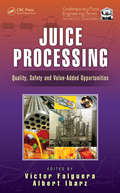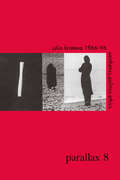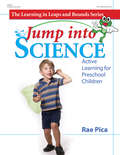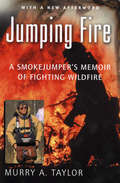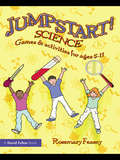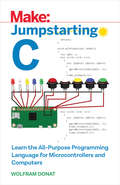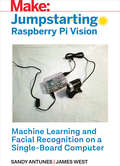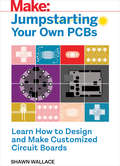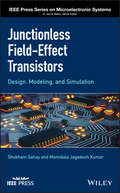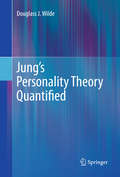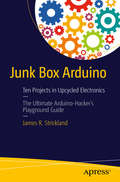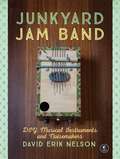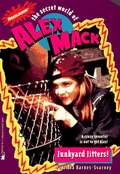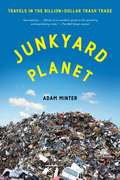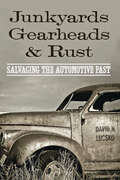- Table View
- List View
Jugad - Kalpak Sanshodhanasathicha Nava Drushtikon: जुगाड: कल्पक संशोधनासाठीचा नवा दृष्टिकोन
by Simone Ahuja Jaideep Prabhu Navi Radjou"जुगाड: कल्पक संशोधनासाठीचा नवा दृष्टिकोन" हे पुस्तक नवी राजू, जयदीप प्रभू, आणि सिमॉन आहुजा यांनी लिहिले आहे आणि संध्या रानडे यांनी मराठीत अनुवादित केले आहे. पुस्तकाच्या प्रस्तावनेत, आर. एन. टाटा यांनी सांगितले आहे की, आधुनिक काळात कंपन्यांना अशा समस्यांना सामोरे जावे लागते ज्यांची त्यांनी कल्पना केली नव्हती. यशस्वी होण्यासाठी, कल्पक संशोधन आवश्यक आहे. पुस्तकात 'जुगाड' या संकल्पनेवर आधारित आहे, ज्याचा अर्थ आहे "निकड भागवण्यासाठी सहज सोप्या पद्धतीने आणि हुशारीने केलेले कल्पक संशोधन." हे संशोधन कमी संसाधनांच्या वापरातून अधिक उत्पन्न कसे मिळवावे यावर लक्ष केंद्रित करते. भारतातील ग्रामीण भागातील लोकांनी, त्यांच्या सभोवतालच्या समस्यांवर सहज आणि सोपे उपाय शोधले आहेत, ज्यामध्ये त्यांनी जुगाड-तत्त्वांचा वापर केला आहे. पुस्तकाचे उद्दिष्ट आहे की, या तत्त्वांचा वापर करून भारतीय कंपन्यांनी आणि उद्योजकांनी त्यांच्या संशोधन पद्धतींमध्ये सुधारणा करावी आणि त्यातून उत्तम परिणाम साधावा. पुस्तकाच्या लेखकांनी जुगाडचे सहा तत्त्वे सांगितले आहेत: कठीण परिस्थितीतही नव्या संधींचा शोध घ्या, कमतरतेतून विपुलता निर्माण करा, विचार आणि कार्यपद्धती यांच्यात लवचीकपणा जपा, साधेपणाला प्राधान्य द्या, वंचितांचा विचार मनात ठेवा, आणि स्वतःच्या मनाचे ऐका. हे पुस्तक भारतातील आणि विकसनशील देशांतील उद्योगजगताच्या दृष्टीने महत्त्वाचे ठरते, कारण ते काटकसर आणि लवचीकता यांचा प्रभावी वापर करून विकास साधण्यासाठी मार्गदर्शन करते.
Juice Processing: Quality, Safety and Value-Added Opportunities (Contemporary Food Engineering)
by Albert Ibarz Víctor FalgueraThe ability to provide quality juices that contain proper vitamins and nutritional components strongly depends on the processes fruits undergo during the various stages of industrial manufacturing. New technologies have been developed to help ensure the production of quality juices without neglecting safety. Covering both new approaches to traditio
Julia Kristeva
by Joanne MorraFirst published in 1998. Routledge is an imprint of Taylor & Francis, an informa company.
Julia Programming for Physics Applications
by R. Gökhan Türeci Hamdi Dağıstanlı İlkay Türk ÇakırNavigating the realm where physics intersects with programming, this book serves as an indispensable guide for students embarking on their journey with Julia. Whether it is plotting equations or analyzing experimental data, mastering computational tools is essential for unraveling the complexities of physical phenomena. Julia, an open-source programming language, emerges as the bridge between simplicity and efficiency. While Python, another open-source language, offers user-friendly syntax, its line-by-line execution often leads to sluggish performance. Julia, however, embodies the ethos of being "as easy as Python but as fast as C/C++," tailored specifically for scientific computing with ongoing developmental enhancements. Notably, Microsoft's AI assistant Copilot is crafted in Julia, showcasing its versatility and adaptability. Within these pages, readers encounter cutting-edge research illustrating Julia's prowess across diverse domains. From streamlined code composition facilitated by modular architecture to the integration of artificial intelligence and graphical visualization, this book illuminates Julia's multifaceted applications. It notably avoids delving into AI algorithms, instead focusing on equipping readers with foundational Julia skills applicable to physics problem-solving. Julia boasts an extensive library ecosystem tailored for scientific computing, empowering users with tools for tasks ranging from differential equation solving to statistical analysis. Its robust support for parallel processing enables swift computations on multi-core systems, a crucial asset for handling voluminous datasets with finesse. Starting with a primer on Julia fundamentals, the book gradually transitions to practical applications across various physics subdomains. From nuclear physics to high-energy phenomena, each chapter offers hands-on exercises that cement comprehension and foster proficiency in employing computational methods to unravel complex physical phenomena. Designed as a precursor to deeper explorations into AI applications within scientific realms, this book lays the groundwork for harnessing Julia's capabilities in physics-centric contexts.
Julian Huxley, Evolutionism and the History of Transhumanism (Palgrave Studies in the Future of Humanity and its Successors)
by Ingrid DunérThe evolutionary biologist Julian Huxley (1887–1975) attempted to promote a “religion for the future,” which he would come to refer to as Transhumanism. Transhumanism was an attempt to unite a more traditional humanistic view of the human as containing some form of core essence or potential with an evolutionary point of view of humans as a work in progress. Before humans, natural selection had been responsible for the transformation of life. Through its ordering principles and through chance, it had given rise to humankind, which had ushered in a new phase of evolution. Humanity stood on the threshold of yet another critical point in evolution: The consciously purposive phase of evolution. This open access book explores the history of transhumanism by analyzing how Julian Huxley’s transhumanism develops and why it does at this particular point in time, by placing it firmly within the context of his specific scientific and sociopolitical milieu, starting roughly in the interwar years and stretching over the Second World War to the 1970s. Continuing, the study then focuses on the new transhumanists of the 1970s, 1980s and 1990s and investigates continuity in mode of thinking, contributing to a more coherent understanding of transhumanism, its history and of modern projects of human enhancement. The book captures how scientific and technological development in relation to society and social order shapes images and expectations of the future and of what future is desirable.
Jumbo: The Making of the Boeing 747
by Chris GallFor the 50th anniversary of the Boeing 747’s first commercial flight, a picture book about the development of the iconic passenger plane and how it changed the history of air travel. In 1968, the biggest passenger jet the world had ever seen premiered in Everett, Washington. The giant plane was called the Boeing 747, but reporters named it “the Jumbo jet.” There was only one problem. It couldn’t fly. Yet.Jumbo details the story of the world’s first wide body passenger jet, which could hold more people than any other plane at the time and played a pivotal role in allowing middle class families to afford overseas travel. Author and illustrator Chris Gall, himself a licensed pilot, shows how an innovative design, hard work by countless people, and ground-breaking engineering put the Jumbo jet in the air. On January 22, 1970, the Boeing 747 made it's first transatlantic flight, taking passengers from New York to Paris in seven hours.
Jump Into Science: Active Learning for Preschool Children
by Rae PicaJump into science with 100 active learning experiences! Jump into Science is the perfect way to turn children's love of active games into learning opportunities! Bring science to life by helping children learn about their bodies, animals, seasons, and the weather. The activities in each chapter are organized by level of difficulty, and each one incorporates fun, exciting science experiences with movement. Most activities require few or no materials and include related children's books or music to extend the learning. The science skills index is an invaluable reference tool, giving teachers flexibility to plan around children's interests. Research shows that the most effective way for children to learn concepts is to experience them physically. Jump into Science offers just this kind of learning. Activities such as The Mirror Game, Dinosaur Stomp, and Water and Ice will actively engage children as they explore new science concepts!
Jumping Fire: A Smokejumper's Memoir of Fighting Wildfire
by Murry A. TaylorThis &“terrifying, grimly funny&” memoir about fighting forest fires in Alaska offers &“an affectionate portrait of a fraternity of daredevils&” (The New Yorker). A Los Angeles Times Best Book of the Year Fighting fires since 1965, legendary smokejumper Murry A. Taylor finally hung up his chute after the summer of 2000—the worst fire season in more than fifty years. In Jumping Fire, Taylor recounts in thrilling detail one summer of parachuting out of planes to battle blazes in the vast, rugged wilderness of Alaska, with tales of training, digging fire lines, run-ins with bears, and the heroics of fellow jumpers who fell in the line of duty. This unique memoir, filled with humor, fear, tragedy, joy, and countless stories of man versus nature at its most furious, is a &“tale of love and loss, life and death, and sheer hard work, set in an unforgiving and unforgettable landscape&” (Publishers Weekly). &“Filled with adventure, danger and tragedy.&” —The New York Times Book Review &“A beautifully crafted, wise yet thrilling book.&” —Los Angeles Times
Jumpstart! Science: Games and Activities for Ages 5-11 (Jumpstart)
by Rosemary FeaseyJumpstart! Science provides teachers with a range of lively, short, fun activities and games to support teaching and learning in different aspects of the science curriculum. It encourages teachers to develop creative approaches to motivating and engaging children in science. The activities are aimed at a number of areas of science from learning scientific words to recalling information and problem solving. This fun book helps to ‘jumpstart’: lessons plenary sessions children moving from one aspect of science or type of learning in science to another. There are more than 55 engaging science games and activities in this book to ‘jumpstart’ science lessons in every Key Stage 1 and 2 classroom. Practical, easy-to-do and highly motivating, the science ‘jumpstarts’ will appeal to busy primary teachers who wish to enliven their practice and add creativity to their science teaching.
Jumpstarting C
by Wolfram DonatAll Make Jumpstart books provide a quick way for makers to "jumpstart" their knowledge of a certain topic.Jumpstarting C takes the reader on a 50-page journey, from installing C on a Raspberry Pi, to creating their first "Hello World" program in C, to building and programming a handheld 4-color memory game using C, pushbuttons and LEDs.
Jumpstarting Raspberry Pi Vision
by Sandy Antunes James WestLearn how to teach a Single Board Computer like a Raspberry Pi to recognize individual faces, using the latest Machine Learning techniques.
Jumpstarting Your Own PCB: Learn How to Design and Make Customized Circuit Boards
by Shawn WallaceLearn to make your own printed circuit boards, using open source software and inexpensive manufacturing techniques!
Jumpstarting the Arduino 101
by Yining Shi Sagar MohiteGet up and running quickly with the new Jumpstarting ebook series from Make:. The Arduino 101 is a low-power board that includes not only Bluetooth LE capabilities but an on-board 6-axis accelerometer/gyroscope for exciting real-world-connected projects.
Jumpstarting the Onion Omega2
by Wolfram DonatGet up and running quickly with the Jumpstarting series!Jumpstarting books provide an avenue for makers to quickly master topical knowledge.Each book starts with instructions on how to install or initialize the hardware or software needed to reach the all-important "Hello, World" stage of getting started.The second project builds on the first to use more of the hardware or software's capabilities.The final project expands the user's knowledge into lesser-known aspects of the topic. All Jumpstarting projects are for Makers -- they provide hands-on, real-world experience in making the hardware or software do what you want it to do.
Junctionless Field-Effect Transistors: Design, Modeling, and Simulation (IEEE Press Series on Microelectronic Systems)
by Shubham Sahay Mamidala Jagadesh KumarA comprehensive one-volume reference on current JLFET methods, techniques, and research Advancements in transistor technology have driven the modern smart-device revolution—many cell phones, watches, home appliances, and numerous other devices of everyday usage now surpass the performance of the room-filling supercomputers of the past. Electronic devices are continuing to become more mobile, powerful, and versatile in this era of internet-of-things (IoT) due in large part to the scaling of metal-oxide semiconductor field-effect transistors (MOSFETs). Incessant scaling of the conventional MOSFETs to cater to consumer needs without incurring performance degradation requires costly and complex fabrication process owing to the presence of metallurgical junctions. Unlike conventional MOSFETs, junctionless field-effect transistors (JLFETs) contain no metallurgical junctions, so they are simpler to process and less costly to manufacture.JLFETs utilize a gated semiconductor film to control its resistance and the current flowing through it. Junctionless Field-Effect Transistors: Design, Modeling, and Simulation is an inclusive, one-stop referenceon the study and research on JLFETs This timely book covers the fundamental physics underlying JLFET operation, emerging architectures, modeling and simulation methods, comparative analyses of JLFET performance metrics, and several other interesting facts related to JLFETs. A calibrated simulation framework, including guidance on SentaurusTCAD software, enables researchers to investigate JLFETs, develop new architectures, and improve performance. This valuable resource: Addresses the design and architecture challenges faced by JLFET as a replacement for MOSFET Examines various approaches for analytical and compact modeling of JLFETs in circuit design and simulation Explains how to use Technology Computer-Aided Design software (TCAD) to produce numerical simulations of JLFETs Suggests research directions and potential applications of JLFETs Junctionless Field-Effect Transistors: Design, Modeling, and Simulation is an essential resource for CMOS device design researchers and advanced students in the field of physics and semiconductor devices.
Jung’s Personality Theory Quantified
by Douglass J. WildeJung's Personality Theory Quantified fills an urgent need for professionals using the Myers-Briggs Type Indicator® (MBTI) to map it on to the cognitive modes of Jung's personality theory, avoiding potential logical errors in the traditional "type dynamics" method. It furthers Jung's original concepts while placing them on a solid axiomatic basis not possessed by other personality theories. Bringing these quantitative findings to the millions of MBTI users - managers, consultants, counsellors, teachers, psychoanalysts and human resource professionals - will require further education of those already certified to administer the instrument according to type dynamics. For this reason numerical exercises follow most chapters to make the book a source reference for briefer workbooks usable in enhanced certification programs. Backed by quantitative theory and new graphical methods, the pioneering qualitative typology work of Myers and Briggs is thus extended to yield deeper understanding of the vital topics of human personality, creativity and human relations. Jungian psychoanalysts may find Jung's Personality Theory Quantified helpful in organizing complicated clinical information and it can also enhance the work of MBTI practitioners worldwide.
Junk Box Arduino
by James R. R. StricklandWe all hate to throw electronics away. Use your 5 volt Arduino and have fun with them instead! Raid your electronics junk box to build the Cestino (Arduino compatible) board and nine other electronics projects, from a logic probe to a microprocessor explorer, and learn some advanced, old-school techniques along the way. Don't have a well-stocked junk box? No problem. Nearly all the components used in these projects are still available (and cheap) at major electronic parts houses worldwide. Junk Box Arduino is the ultimate have-fun-while-challenging-your-skills guide for Arduino hackers who've gone beyond the basic tutorials and are ready for adventures in electronics. Bonus materials include all the example sketches, the Cestino core and bootloader source code, and links to suppliers for parts and tools. Bonus materials include extensions to the Cestino, Sourceforge links for updated code, and all the source-code for the projects.
Junkware (Posthumanities #13)
by Thierry BardiniAre we made of junk? Thierry Bardini believes we are. Examining an array of cybernetic structures from genetic codes to communication networks, he explores the idea that most of culture and nature, including humans, is composed primarily of useless, but always potentially recyclable, material otherwise known as "junk." Bardini unravels the presence of junk at the interface between science fictions and fictions of science, showing that molecular biology and popular culture since the early 1960s belong to the same culture-cyberculture-which is essentially a culture of junk. He draws on a wide variety of sources, including the writings of Philip K. Dick and William S. Burroughs, interviews with scientists as well as "crackpots," and work in genetics, cybernetics, and physics to support his contention that junk DNA represents a blind spot in our understanding of life.At the same time, Junkware examines the cultural history that led to the encoding and decoding of life itself and the contemporary turning of these codes into a commodity. But he also contends that, beyond good and evil, the essential "junkiness" of this new subject is both the symptom and the potential cure.
Junkyard Jam Band: DIY Musical Instruments and Noisemakers
by David Erik NelsonMaking music doesn’t have to be about dropping big bucks in the guitar shop or endlessly fiddling with expensive software. You can make good noise out of bits of wood and wire, plastic and steel. When you build your own instruments, creating your own sound comes naturally.Junkyard Jam Band is a step-by-step guide to making a full array of complete musical projects—no previous carpentry or electronics experience required. Each build includes tips on how to coax the best sounds out of the instrument and encourages you to mod the project to fit your own style.Learn how to:–Bust up your old tape decks for a handheld old-skool Scratchbox–Give your voice a robotic makeover with the Droid Voicebox–Circuit-bend unsuspecting childhood toys into mutant glitching jazz-punk machines–Transform cigar boxes into thumb pianos and electric ukuleles–Build a crackling, multifunction Mud-n-Sizzle Preamp to attach to any electric music machineAlong the way, you’ll explore the physics behind wind instruments, discover how harmonics work, and get your feet wet with some music theory. To top it all off, the back of the book includes a soldering primer for total beginners, along with extra circuits to customize your instruments even further.Build your own band your way!
Junkyard Jitters! (The Secret World of Alex Mack #11)
by Patricia Barnes-SvarneyWhen Ray asks Alex to help him with his paper route, she can hardly turn him down. What are best friends for, anyway? But tossing the news is hard work, and Alex can't resist using her powers to help out. Not that there's anyone around to see...except the eccentric old inventor who lives in the junkyard. When he catches Alex flowing like a lightning bug, she's only a little worried. But then the goons from Paradise Valley Chemical show up at the junkyard, too. Did the old man blow the whistle on her? Or is he working for the plant...on an invention to catch the GC-161 kid?
Junkyard Planet: Travels in the Billion-Dollar Trash Trade
by Adam Minter<p>When you drop your Diet Coke can or yesterday's newspaper in the recycling bin, where does it go? Probably halfway around the world, to people and places that clean up what you don't want and turn it into something you can't wait to buy. In Junkyard Planet, Adam Minter--veteran journalist and son of an American junkyard owner--travels deep into a vast, often hidden, five-hundred-billion-dollar industry that's transforming our economy and environment. <p>With unmatched access to and insight on the waste industry, and the explanatory gifts and an eye for detail worthy of a John McPhee or a William Langewiesche, Minter traces the export of America's junk and the massive profits that China and other rising nations earn from it. What emerges is an engaging, colorful, and sometimes troubling tale of how the way we consume and discard stuff fuels a world that recognizes value where Americans don't. Junkyard Planet reveals that Americans might need to learn a smarter way to take out the trash.</p>
Junkyards, Gearheads, and Rust: Salvaging the Automotive Past
by David N. LucskoThe material appeal of the automobile junkyard goes beyond the search for second-hand parts.What happens to automobiles after they are retired but before they are processed as scrap? In this fascinating history, David N. Lucsko takes readers on a tour of salvage yards and wrecked or otherwise out-of-service cars in the United States from the point of view of gearheads—the hot rodders, restoration hobbyists, street rodders, and classic car devotees who reuse, repurpose, and restore junked cars.Junkyards, Gearheads, and Rust is a nuanced exploration of the business of dismantling wrecks and selling second-hand parts. It examines the reinterpretation of these cars and parts by artists as well as their restoration by enthusiasts. It also surveys the origin and evolution of gearhead-oriented yards that specialize in specific types of automobiles; dissects the material and emotional appeal of the salvage yard and its contents among enthusiasts; and examines how zoning and nuisance ordinances have affected both salvage businesses and hobbyists. Lucsko concludes with an analysis of efforts during the last twenty-five years to hasten vehicular obsolescence at the expense of salvage yards, mechanics, and enthusiasts. By examining how cars are salvaged, repurposed, and restored, this book demonstrates that the history of the automobile is much more than a running catalog of showroom novelties.
Jupiter's Gift
by John SamonyTim is working on his science fair project—a robot! When he spends a weekend afternoon with his great-uncle, he learns that his love of engineering and technology runs in the family. After Great-Uncle Bate lends him a little creativity to help figure out what’s wrong with the robot, Tim learns an awesome secret about him!
Just Culture and the Criminalisation of Air Accidents
by Simon DanielsJust Culture and the Criminalisation of Air Accidents equips the reader with the tools to understand the meaning of criminalisation in the civil aviation industry. It enables them to resolve problems that arise in risk management within the context of their professional employment.By examining the priorities of pilots, air traffic controllers and prosecutors, this book analyses the anatomy of criminalisation in civil aviation and works towards constructing solutions that protect the professionals’ human rights and the Just Culture concept within the framework of criminal law and practice. It covers the duty of an air traffic controller to take the standard of care to guard against acts or omissions which might cause loss and give rise to a claim in negligence. The book illustrates the critical features discussed with numerous case studies from States and jurisdictions around the world.The book will benefit airline operators, pilots, air traffic controllers or managers, and aviation business managers.
Just Culture: Balancing Safety and Accountability
by Sidney DekkerBuilding on the success of the 2007 original, Dekker revises, enhances and expands his view of just culture for this second edition, additionally tackling the key issue of how justice is created inside organizations. The goal remains the same: to create an environment where learning and accountability are fairly and constructively balanced. The First Edition of Sidney Dekker’s Just Culture brought accident accountability and criminalization to a broader audience. It made people question, perhaps for the first time, the nature of personal culpability when organizational accidents occur. Having raised this awareness the author then discovered that while many organizations saw the fairness and value of creating a just culture they really struggled when it came to developing it: What should they do? How should they and their managers respond to incidents, errors, failures that happen on their watch? In this Second Edition, Dekker expands his view of just culture, additionally tackling the key issue of how justice is created inside organizations. The new book is structured quite differently. Chapter One asks, ’what is the right thing to do?’ - the basic moral question underpinning the issue. Ensuing chapters demonstrate how determining the ’right thing’ really depends on one’s viewpoint, and that there is not one ’true story’ but several. This naturally leads into the key issue of how justice is established inside organizations and the practical efforts needed to sustain it. The following chapters place just culture and criminalization in a societal context. Finally, the author reflects upon why we tend to blame individual people for systemic failures when in fact we bear collective responsibility. The changes to the text allow the author to explain the core elements of a just culture which he delineated so successfully in the First Edition and to explain how his original ideas have evolved. Dekker also introduces new material on ethics and on caring

